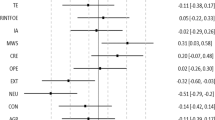Abstract
The heights of female and male corporate employees in management and nonmanagement positions were evaluated in two studies in order to determine if there were height differences between the two groups, and if there were any gender × job status (management or nonmanagement) interactions with respect to height. Two studies were conducted having 201 and 200 subjects respectively. Both studies used a two-factor (gender × job status) factorial design and both studies showed that managerial (high status) employees were significantly (p≤.006) taller than those occupying nonmanagement positions, regardless of gender. Possible reasons for the overall phenomenon of taller individuals occupying higher status positions are discussed.
Similar content being viewed by others
References
Bleda, P. R., & Bleda, S. E. (1977). Attitude similarity, attraction, perception of height, and judgment of agreement. Representative Research in Social Psychology, 8, 57–61.
Dannenmaier, W. D., & Thumin, F. J. (1964). Authority status as a factor in perceptual distortion of size. Journal of Social Psychology, 63, 361–365.
Deck, L. P. (1968). Buying brains by the inch. The Journal of College and University Personnel Association, 19, 33–37.
Feingold, A. (1982). Do taller men have prettier girlfriends? Psychological Reports, 50, 810.
Frieze, I. H., Olson, J. E., & Good, D. C. (1990). Perceived and actual discrimination in the salaries of male and female managers. Journal of Applied Social Psychology, 20, 46–67.
Graziano, W., Brothen, T., & Berscheid, E. (1978). Height and attraction: Do men and women see eye-to-eye? Journal of Personality, 46, 128–145.
Hensley, W. E. (1983). Gender, self-esteem and height. Perceptual and Motor Skills, 56, 235–238.
Hensley, W. E., & Cooper, R. (1987). Height and occupational success: A review and critique. Psychological Reports, 60, 843–849.
Humphreys, L. G., Davey, T. C., & Park, R. K. (1985). Longitudinal correlation analysis of standing height and intelligence. Child Development, 56, 1465–1478.
Keyes, R. (1980). The height of your life. Boston: Little, Brown, and Co.
Lechelt, E. C. (1975). Occupational affiliation and ratings of physical height and personal esteem. Psychological Reports, 36, 943–946.
Lerner, R. M., & Moore, T. (1974). Sex and status effects on perception of physical attractiveness. Psychological Reports, 34, 1047–1050.
Morrow, J. (1984). Deviational salience: Application to short stature and relation to perception of adolescent boys. Perceptual and Motor Skills, 59, 623–633.
Nagoshi, C. T., & Johnson, R. C. (1987). Between-vs. within-family analyses of the correlation of height and intelligence. Social Biology, 34, 110–113.
Prieto, A. G., & Robbins, M. C. (1975). Perceptions of height and self-esteem. Perceptual and Motor Skills, 40, 395–398.
Tanner, J. M. (1966). Galtonian eugenics and the study of growth: The relation of body size, intelligence test score, and social circumstances in children and adults. The Eugenics Review, 58, 122–135.
Wilson, D. M., Hammer, L. D., Duncan, P., Dornbusch, S., Ritter, P., Hintz, R., Gross, R., & Rosendfeld, R. (1986). Growth and intellectual development. Pediatrics, 78, 646–650.
Wilson, P. R. (1968). Perceptual distortion of height as a function of ascribed academic status. The Journal of Social Psychology, 74, 97–102.
Author information
Authors and Affiliations
Additional information
The authors wish to thank Susan L. Bertone, Sharon McClelland, and Earl Munch for their assistance with this research project. Part of the information contained in this article was presented at the 1989 annual convention of the Eastern Communication Association in Ocean City, Maryland.
Rights and permissions
About this article
Cite this article
Egolf, D.B., Corder, L.E. Height differences of low and high job status, female and male corporate employees. Sex Roles 24, 365–373 (1991). https://doi.org/10.1007/BF00288309
Issue Date:
DOI: https://doi.org/10.1007/BF00288309




